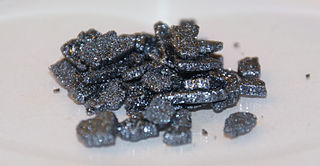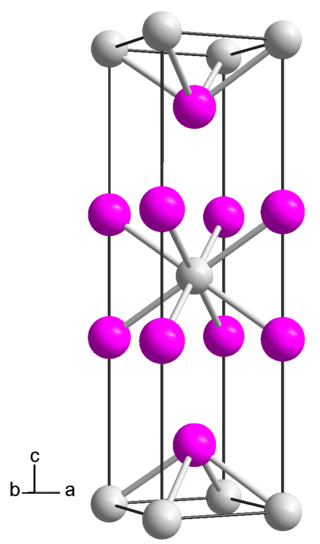Related Research Articles

Iodine is a chemical element; it has symbol I and atomic number 53. The heaviest of the stable halogens, it exists at standard conditions as a semi-lustrous, non-metallic solid that melts to form a deep violet liquid at 114 °C (237 °F), and boils to a violet gas at 184 °C (363 °F). The element was discovered by the French chemist Bernard Courtois in 1811 and was named two years later by Joseph Louis Gay-Lussac, after the Ancient Greek Ιώδης 'violet-coloured'.

In chemistry, triiodide usually refers to the triiodide ion, I−
3. This anion, one of the polyhalogen ions, is composed of three iodine atoms. It is formed by combining aqueous solutions of iodide salts and iodine. Some salts of the anion have been isolated, including thallium(I) triiodide (Tl+[I3]−) and ammonium triiodide ([NH4]+[I3]−). Triiodide is observed to be a red colour in solution.

Titanium tetraiodide is an inorganic compound with the formula TiI4. It is a black volatile solid, first reported by Rudolph Weber in 1863. It is an intermediate in the van Arkel–de Boer process for the purification of titanium.
Silicon tetraiodide is the chemical compound with the formula SiI4. It is a tetrahedral molecule with Si-I bond lengths of 2.432(5) Å.

Tellurium tetraiodide (TeI4) is an inorganic chemical compound. It has a tetrameric structure which is different from the tetrameric solid forms of TeCl4 and TeBr4. In TeI4 the Te atoms are octahedrally coordinated and edges of the octahedra are shared.
Iodine compounds are compounds containing the element iodine. Iodine can form compounds using multiple oxidation states. Iodine is quite reactive, but it is much less reactive than the other halogens. For example, while chlorine gas will halogenate carbon monoxide, nitric oxide, and sulfur dioxide, iodine will not do so. Furthermore, iodination of metals tends to result in lower oxidation states than chlorination or bromination; for example, rhenium metal reacts with chlorine to form rhenium hexachloride, but with bromine it forms only rhenium pentabromide and iodine can achieve only rhenium tetraiodide. By the same token, however, since iodine has the lowest ionisation energy among the halogens and is the most easily oxidised of them, it has a more significant cationic chemistry and its higher oxidation states are rather more stable than those of bromine and chlorine, for example in iodine heptafluoride.
Tin(IV) iodide, also known as stannic iodide, is the chemical compound with the formula SnI4. This tetrahedral molecule crystallizes as a bright orange solid that dissolves readily in nonpolar solvents such as benzene.

Germanium(II) iodide is an iodide of germanium, with the chemical formula of GeI2.

Germanium(IV) iodide is an inorganic compound with the chemical formula GeI4.

Phosphonium iodide is a chemical compound with the formula PH
4I. It is an example of a salt containing an unsubstituted phosphonium cation. Phosphonium iodide is commonly used as storage for phosphine and as a reagent for substituting phosphorus into organic molecules.
Iron(III) iodide is an inorganic compound with the chemical formula FeI3. It is a thermodynamically unstable compound that is difficult to prepare. Nevertheless, iron(III) iodide has been synthesised in small quantities in the absence of air and water.
Osmium iodide refers to compounds of osmium with the formula OsIn. Several have been mentioned in the literature, but all iodides except the tetraiodide have been verified by X-ray crystallography.

Neodymium(II) iodide or neodymium diiodide is an inorganic salt of iodine and neodymium the formula NdI2. Neodymium uses the +2 oxidation state in the compound.

Lanthanum diiodide is an iodide of lanthanum, with the chemical formula of LaI2. It is an electride, actually having a chemical formula of La3+[(I−)2e−].

Cerium diiodide is an iodide of cerium, with the chemical formula of CeI2.
Rhenium compounds are compounds formed by the transition metal rhenium (Re). Rhenium can form in many oxidation states, and compounds are known for every oxidation state from -3 to +7 except -2, although the oxidation states +7, +4, and +3 are the most common. Rhenium is most available commercially as salts of perrhenate, including sodium and ammonium perrhenates. These are white, water-soluble compounds. The tetrathioperrhenate anion [ReS4]− is possible.
Technetium pentaluoride is a binary inorganic chemical compound of technetium metal and fluorine with the chemical formula TcF
5.
Iridium(IV) iodide is a binary chemical compound of iridium and iodide with the chemical formula IrI
4.

Rhenium(III) iodide is a binary chemical compound of rhenium and iodide with the chemical formula ReI
3.

Niobium(IV) iodide is an iodide of niobium, with the chemical formula of NbI4.
References
- ↑ "WebElements Periodic Table » Rhenium » rhenium tetraiodide". webelements.com. Retrieved 7 May 2023.
- ↑ Brown, D.; Colton, R. (June 1963). "Preparation of Rhenium Tetrachloride". Nature . 198 (4887): 1300–1301. Bibcode:1963Natur.198.1300B. doi:10.1038/1981300a0. ISSN 1476-4687. S2CID 4208748 . Retrieved 7 May 2023.
- ↑ Colton, R.; Levitus, R.; Wilkinson, G. (1 January 1960). "806. Some complex compounds of rhenium". Journal of the Chemical Society (Resumed): 4121–4126. doi:10.1039/JR9600004121. ISSN 0368-1769 . Retrieved 7 May 2023.
- ↑ Kemmitt, R. D. W.; Peacock, R. D. (26 January 2016). The Chemistry of Manganese, Technetium and Rhenium: Pergamon Texts in Inorganic Chemistry. Elsevier. p. 921. ISBN 978-1-4831-8762-4 . Retrieved 7 May 2023.
- 1 2 3 Savit︠s︡kiĭ, Evgeniĭ Mikhaĭlovich; Tulkina, Marii︠a︡ Aronovna; Povarova, Kira Borisovna (1970). Rhenium Alloys. Israel Program for Scientific Translations; [available from the U.S. Department of Commerce, Clearinghouse for Federal Scientific and Technical Information, Springfield, Va.] p. 62. Retrieved 9 May 2023.
- ↑ "CharChem. Rhenium(IV) iodide". easychem.org. Retrieved 9 May 2023.